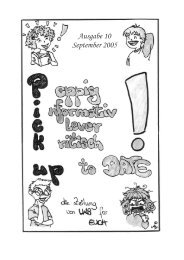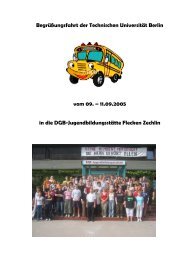Elegantes Telefax - JAV der TUB - TU Berlin
Elegantes Telefax - JAV der TUB - TU Berlin
Elegantes Telefax - JAV der TUB - TU Berlin
You also want an ePaper? Increase the reach of your titles
YUMPU automatically turns print PDFs into web optimized ePapers that Google loves.
17<br />
the reorganization in 1987 created better resource conditions for the EA process,<br />
the external literature agrees that remaining conflicts between environmental<br />
staff and country managers about the adequate procedure for the integration<br />
of environmental criteria into the design, implementation and operation<br />
of project were not adequately resolved. 8 The main explanations centre on the<br />
incentive structure of the project managers. 9<br />
• The 1987 reorganization is consi<strong>der</strong>ed more successful in creating incentives for<br />
separate environmental lending. Environmental professionals in the regional divisions<br />
were free and had the resources to identify potential environmentally<br />
beneficial projects in borrowing countries and find supporters within the governmental<br />
agencies. An additional incentive to identify and promote environmentally<br />
beneficial projects is the result of the establishment of the Global Environment<br />
Facility (GEF) in 1991 for which the World Bank is one of the implementing<br />
agencies and for which it hosts the independent secretariat. The GEF has a<br />
completely different principal structure and decision rules about projects, so that<br />
the GEF projects cannot simply be added to the portfolio of the Environment<br />
Department of the World Bank, but they increase the leverage of the environmental<br />
staff of the Bank in promoting environmental projects.<br />
• Nielson and Tierney (2003; 2005) see the creation of the Inspection Panel in<br />
1994, which was based on the same influencing mechanism of an NGO demand<br />
leveraged by the US Congress who had to agree to an IDA replenishment, as<br />
the organizational “reform that sticks” (Nielson and Tierney 2003, 260). But, they<br />
add that this change was supported by the Board which reflects changes of the<br />
preferences of the major principals around the UNCED process and complemented<br />
by changes in the reporting requirements: One was to make project documents<br />
publicly available including the environmental assessments and to get<br />
the Board involved earlier in the planning cycle of the project and not only for<br />
approval.<br />
• The 1997 reorganization changed the incentive structure from a supply oriented<br />
to a more demand (by the recipient governments) driven approach (Gutner<br />
2002). The country managers controlled the operating and administrative budgets<br />
and the Bank wide technical networks which included the environmental staff<br />
8 NGOs claimed that their cases proved the overall picture. But even World Bank internal reports raised<br />
a number of weaknesses in the appraisal and monitoring process (World Bank 1992; World Bank<br />
1996b).<br />
9 Rich 1994 focuses on the incentives to get approval for projects, later (Rich 2002) adds staff turnover<br />
and lack of institutional continuity; Wade (1997) diagnoses a bargaining situation between task managers<br />
and environmental staff; Gutner (2002, 93) sees the restriction in the pursuit of keeping the<br />
transaction costs of projects low as a major point.





